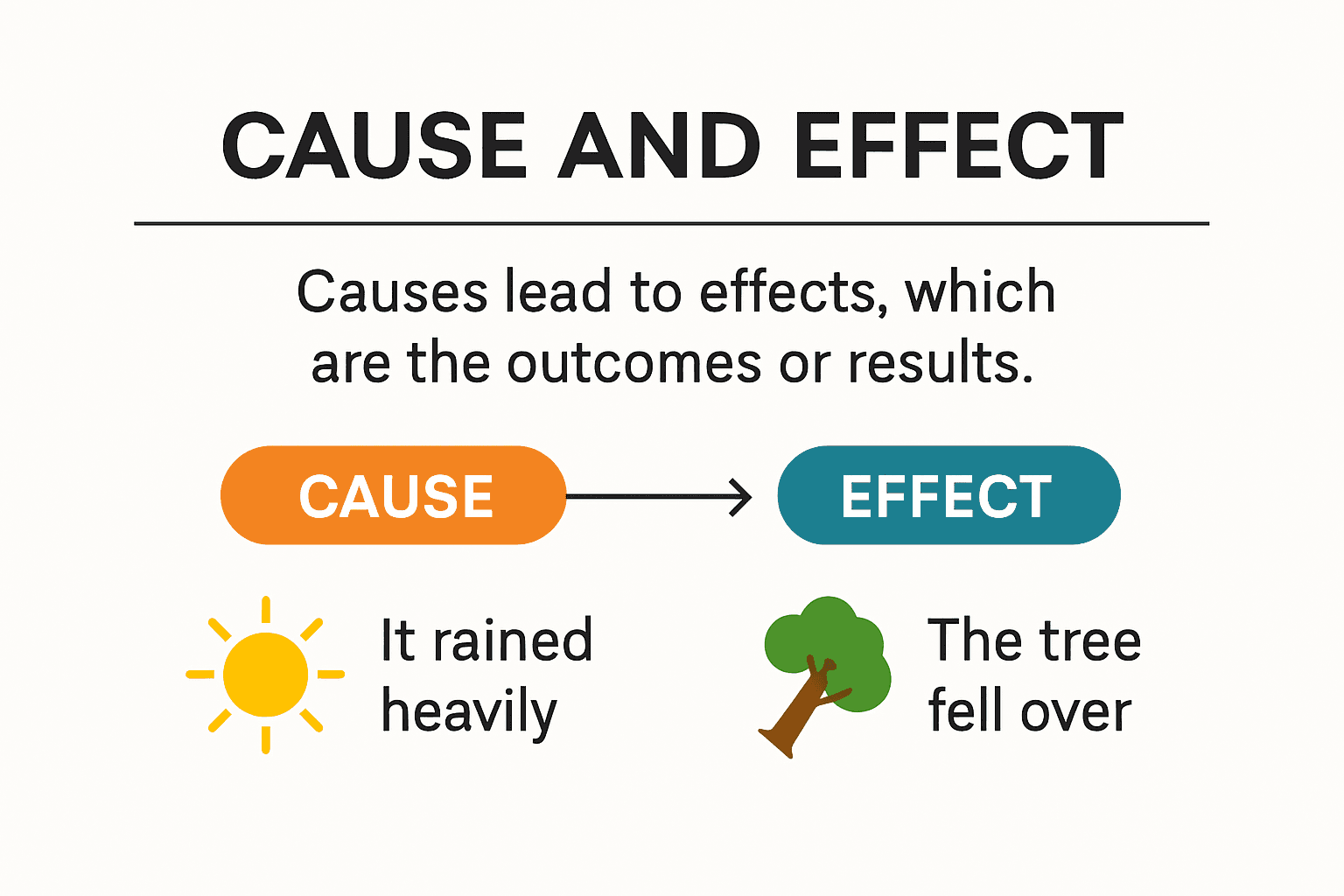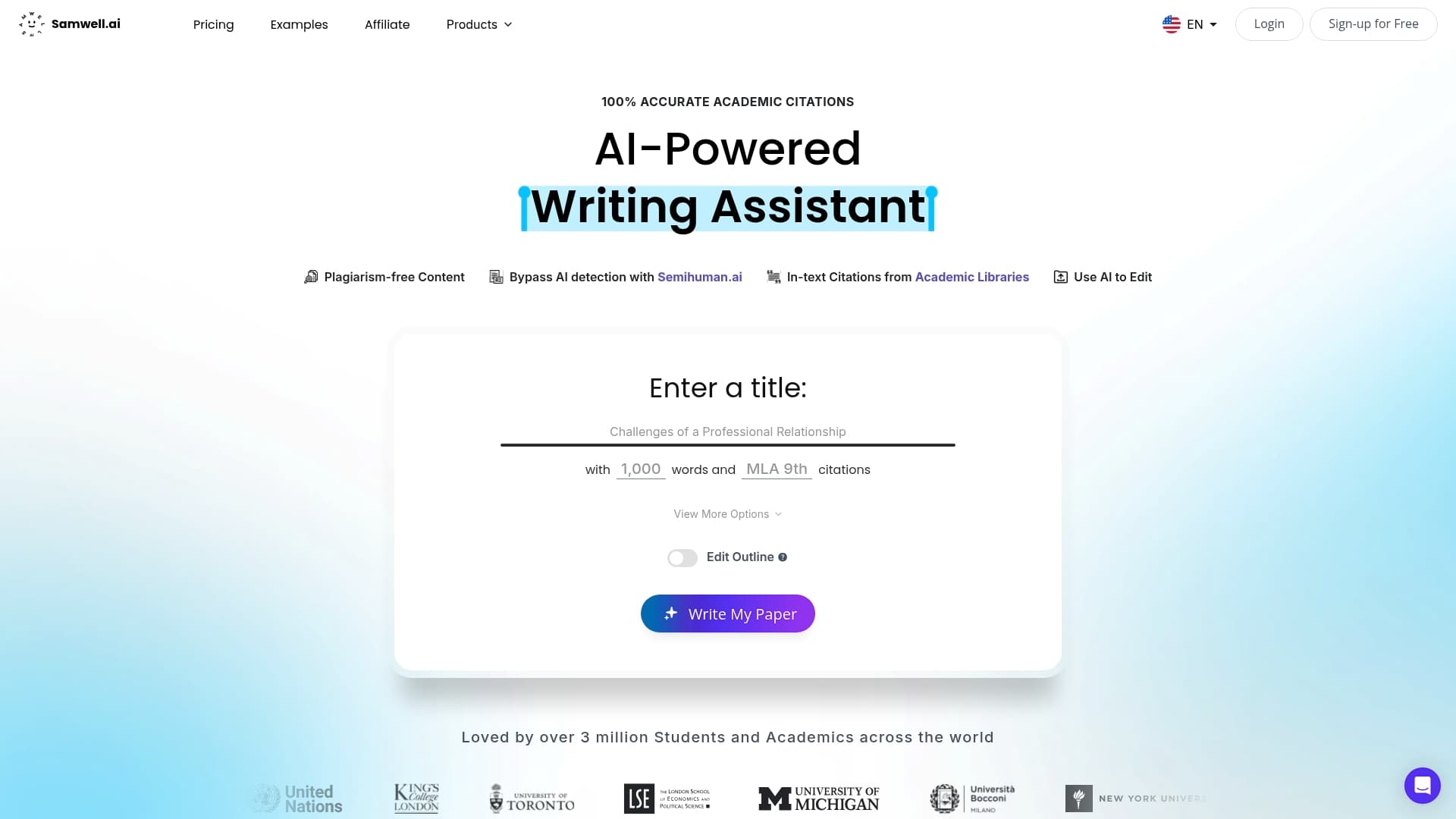Blog
Learning Materials
Best Cause and Effect Writing Examples for 2025
Updated: July 8, 2025

Everyone writes about cause and effect, but few realize how vital this skill is outside the classroom. Think about this. One structural approach to cause and effect writing helps students create essays that are proven to boost comprehension by up to 30 percent according to recent literacy research. Yet, most people overlook how these same strategies power advanced research, public policy, and even corporate decision-making. The real secret is that mastering cause and effect writing can turn complex ideas into clear, persuasive arguments far beyond school assignments.
Table of Contents
- What Is Cause And Effect Writing? Dockerfile README.md email-templates i18n-config.ts i18nConfig.ts next-sitemap-samwell.config.js next-sitemap-semihuman.config.js next.config.js node_modules package-lock.json package.json process_content.js public scripts src svgr.d.ts translations tsconfig.json Understanding The Core Mechanism Dockerfile README.md email-templates i18n-config.ts i18nConfig.ts next-sitemap-samwell.config.js next-sitemap-semihuman.config.js next.config.js node_modules package-lock.json package.json process_content.js public scripts src svgr.d.ts translations tsconfig.json Structural Approaches To Cause And Effect Analysis Dockerfile README.md email-templates i18n-config.ts i18nConfig.ts next-sitemap-samwell.config.js next-sitemap-semihuman.config.js next.config.js node_modules package-lock.json package.json process_content.js public scripts src svgr.d.ts translations tsconfig.json Academic And Professional Significance
- Types Of Cause And Effect Writing Examples Dockerfile README.md email-templates i18n-config.ts i18nConfig.ts next-sitemap-samwell.config.js next-sitemap-semihuman.config.js next.config.js node_modules package-lock.json package.json process_content.js public scripts src svgr.d.ts translations tsconfig.json Single Cause Multiple Effects Approach Dockerfile README.md email-templates i18n-config.ts i18nConfig.ts next-sitemap-samwell.config.js next-sitemap-semihuman.config.js next.config.js node_modules package-lock.json package.json process_content.js public scripts src svgr.d.ts translations tsconfig.json Multiple Causes Single Effect Analysis Dockerfile README.md email-templates i18n-config.ts i18nConfig.ts next-sitemap-samwell.config.js next-sitemap-semihuman.config.js next.config.js node_modules package-lock.json package.json process_content.js public scripts src svgr.d.ts translations tsconfig.json Causal Chain Exploration
- Step-By-Step Guide To Writing Cause And Effect Essays Dockerfile README.md email-templates i18n-config.ts i18nConfig.ts next-sitemap-samwell.config.js next-sitemap-semihuman.config.js next.config.js node_modules package-lock.json package.json process_content.js public scripts src svgr.d.ts translations tsconfig.json Preparation And Topic Selection Dockerfile README.md email-templates i18n-config.ts i18nConfig.ts next-sitemap-samwell.config.js next-sitemap-semihuman.config.js next.config.js node_modules package-lock.json package.json process_content.js public scripts src svgr.d.ts translations tsconfig.json Structuring Your Essay Effectively Dockerfile README.md email-templates i18n-config.ts i18nConfig.ts next-sitemap-samwell.config.js next-sitemap-semihuman.config.js next.config.js node_modules package-lock.json package.json process_content.js public scripts src svgr.d.ts translations tsconfig.json Crafting Persuasive Supporting Evidence
- Tips And Resources For Educators And Researchers Dockerfile README.md email-templates i18n-config.ts i18nConfig.ts next-sitemap-samwell.config.js next-sitemap-semihuman.config.js next.config.js node_modules package-lock.json package.json process_content.js public scripts src svgr.d.ts translations tsconfig.json Instructional Strategies For Teaching Cause And Effect Dockerfile README.md email-templates i18n-config.ts i18nConfig.ts next-sitemap-samwell.config.js next-sitemap-semihuman.config.js next.config.js node_modules package-lock.json package.json process_content.js public scripts src svgr.d.ts translations tsconfig.json Research Methodologies And Advanced Analysis Dockerfile README.md email-templates i18n-config.ts i18nConfig.ts next-sitemap-samwell.config.js next-sitemap-semihuman.config.js next.config.js node_modules package-lock.json package.json process_content.js public scripts src svgr.d.ts translations tsconfig.json Technological Tools And Research Resources
Quick Summary
| Takeaway | Explanation |
|---|---|
| Understanding Cause and Effect Writing | This writing style examines how specific circumstances generate outcomes, focusing on the relationships between actions and their consequences. |
| Types of Approaches | Writers can use two main structural approaches: analyzing multiple causes for a single effect or one cause leading to multiple effects, each revealing different insights into causal relationships. |
| Writing Process | A clear and systematic writing process is essential, including strategic topic selection, effective essay structuring, and robust supporting evidence to clarify causal connections. |
| Educational Strategies | Educators should utilize graphic organizers, hands-on experiments, and interactive classroom activities to enhance students’ understanding of cause and effect relationships. |
| Advanced Research Techniques | Researchers must employ rigorous methodologies, including mixed-method designs and statistical analysis, to uncover complex causal relationships and their implications. |
What Is Cause and Effect Writing?
 Cause and effect writing represents a powerful analytical approach that explores the intricate relationships between events, actions, and their consequences. This writing style systematically examines how specific circumstances generate particular outcomes, providing readers with a comprehensive understanding of complex interconnections.
Cause and effect writing represents a powerful analytical approach that explores the intricate relationships between events, actions, and their consequences. This writing style systematically examines how specific circumstances generate particular outcomes, providing readers with a comprehensive understanding of complex interconnections.
Understanding the Core Mechanism
At its fundamental level, cause and effect writing breaks down complex scenarios into clear causal chains. Writers identify a specific event or situation and meticulously trace its origins and subsequent impacts. The primary goal is to demonstrate how one phenomenon directly influences another, creating a logical narrative that helps readers comprehend the underlying mechanisms of change.
For instance, a writer might explore how economic policies can transform student learning opportunities. By analyzing the causes and subsequent effects, the essay reveals the intricate connections that might not be immediately apparent.

Structural Approaches to Cause and Effect Analysis
Cause and effect writing typically follows two primary organizational strategies. The first approach focuses on exploring multiple causes that lead to a single effect. In this method, writers investigate various factors contributing to a specific outcome. For example, analyzing the reasons behind student dropout rates might involve examining economic challenges, personal motivation, academic preparation, and social support systems.
The second approach reverses this structure, examining a single cause and its multiple potential effects. This strategy allows writers to demonstrate the broader implications of a particular event or decision. A classic example might involve exploring how technological advancements impact employment markets, social interactions, and personal communication patterns.
To help readers visualize the main approaches to structuring cause and effect analysis, the following table summarizes their key features and examples discussed above.
| Approach | Description | Example Topic |
|---|---|---|
| Multiple Causes → Single Effect | Examines various factors leading to one outcome | Factors behind student dropout rates |
| Single Cause → Multiple Effects | Explores how one event produces several different outcomes | Impact of technology on jobs, society, and communication |
| Causal Chain (Domino Effect) | Traces a series of linked causes and effects, each effect becoming a cause | Global warming → glacier melt → sea-level rise... |
Academic and Professional Significance
Cause and effect writing extends far beyond academic exercises. According to research from Butte College, this writing technique is crucial in disciplines ranging from social sciences and economics to environmental studies and public policy. Researchers and professionals use this analytical approach to understand complex systemic interactions, predict potential outcomes, and develop strategic interventions.
The methodology demands rigorous critical thinking, requiring writers to provide substantial evidence, draw logical connections, and present arguments with clarity and precision. Students and professionals alike develop sophisticated analytical skills by practicing this writing technique, learning to deconstruct complex scenarios into comprehensible causal relationships.
Whether you are crafting an academic paper, conducting professional research, or seeking to understand intricate social dynamics, cause and effect writing offers a structured framework for exploring the fascinating web of interconnected events that shape our world.
Types of Cause and Effect Writing Examples
Cause and effect writing encompasses various structural approaches that help writers systematically explore complex relationships between events, actions, and their consequences. Understanding these different types enables writers to effectively communicate intricate causal connections across academic, professional, and creative domains.
Single Cause Multiple Effects Approach
In this type of cause and effect writing, authors focus on a singular event or phenomenon and meticulously examine its wide-ranging impacts. Explore comprehensive essay strategies that demonstrate how one primary cause can generate multiple significant effects. According to research from Lumen Learning, this approach allows writers to showcase the extensive ripple effects of a particular event.
For instance, a writer might analyze how technological innovation in artificial intelligence creates cascading effects on employment markets, educational systems, and social interactions. By tracing these interconnected consequences, the writer reveals the profound systemic implications of a single transformative force.
Multiple Causes Single Effect Analysis
Alternatively, writers can reverse the structural approach by investigating multiple contributing factors that collectively produce a specific outcome. This method is particularly powerful in complex scenarios where no single cause completely explains an event. According to eReading Worksheets, effective cause and effect writing uses strategic signal words like "because," "due to," and "as a result" to clarify these intricate relationships.
A classic example might involve analyzing student academic performance. Instead of attributing success or failure to one factor, this approach would examine how economic background, family support, personal motivation, educational resources, and teaching quality collectively influence academic outcomes.
Causal Chain Exploration
The causal chain represents a sophisticated cause and effect writing technique where writers trace a sequence of interconnected events. Each effect becomes a subsequent cause, creating a dynamic narrative of continuous transformation. Research from academic writing resources highlights this approach as particularly effective for demonstrating complex systemic interactions.
In environmental studies, for example, a causal chain might explore how rising global temperatures trigger glacier melting, which leads to sea-level increases, subsequently causing coastal erosion, impacting marine ecosystems, and ultimately affecting human settlements. This method allows writers to demonstrate the intricate, interconnected nature of global phenomena.

Each type of cause and effect writing offers unique insights, enabling writers to dissect complex scenarios, reveal hidden connections, and provide readers with comprehensive understanding of how events interrelate and transform. The choice of approach depends on the specific subject matter, writing goals, and the complexity of the causal relationships being explored.
Step-by-Step Guide to Writing Cause and Effect Essays
Crafting a compelling cause and effect essay requires a systematic approach that transforms complex relationships into clear, logical narratives. This comprehensive guide breaks down the writing process into manageable steps, helping writers effectively analyze and communicate causal connections.
To further clarify the process of writing an effective cause and effect essay, below is a step-by-step table outlining the key phases and their essential elements described in this section.
| Step | Focus | Key Actions & Considerations |
|---|---|---|
| Preparation | Topic selection & research | Choose suitable topic; ensure clear causal links; gather credible sources |
| Structuring | Organize essay | Craft thesis statement; define structure: intro, body, conclusion |
| Supporting Evidence | Building argument & credibility | Use data, expert opinions, examples; address alternative explanations |
| Writing & Review | Compose & refine essay | Apply logical flow, transitions, and revise for clarity and accuracy |
Preparation and Topic Selection
The foundation of an exceptional cause and effect essay begins with strategic topic selection and thorough preparation. Explore comprehensive essay strategies that can elevate your writing approach. According to research from Kellogg Educational Resources, successful essays start with a clear understanding of the assignment and a well-defined scope.
Begin by identifying a topic with clear causal relationships. Choose subjects that offer multiple perspectives and demonstrable connections. Consider areas like social phenomena, scientific processes, historical events, or contemporary issues that reveal intricate cause-and-effect dynamics. Conduct preliminary research to ensure sufficient evidence and credible sources are available to support your analysis.
Structuring Your Essay Effectively
Developing a robust essay structure is crucial for presenting causal relationships coherently. Academic writing resources recommend a clear organizational approach that typically includes:
- Introduction: Craft a compelling thesis statement that explicitly outlines the causal relationship you will explore
- Body Paragraphs: Systematically present causes, effects, or both, using strong evidence and logical transitions
- Conclusion: Synthesize your findings and reinforce the significance of the causal connections
According to Delmar Library research, effective cause and effect essays require careful use of transitional phrases like "because," "consequently," and "as a result" to maintain logical flow between ideas.
Crafting Persuasive Supporting Evidence
The strength of a cause and effect essay lies in its supporting evidence. Each claim must be substantiated with credible sources, statistical data, expert opinions, or concrete examples. Writers should focus on:
- Identifying direct and immediate causal relationships
- Qualifying statements to avoid overgeneralization
- Using a variety of evidence types (historical data, scientific studies, expert testimony)
- Maintaining a critical and analytical approach
Pay special attention to potential alternative explanations and acknowledge the complexity of causal relationships. Avoid oversimplifying complex interactions by presenting nuanced, well-researched arguments.
Successful cause and effect writing transforms abstract connections into clear, compelling narratives. By following these systematic steps, writers can develop sophisticated essays that illuminate the intricate ways events, phenomena, and actions interconnect and influence one another. The key is to approach the writing process with curiosity, rigor, and a commitment to logical analysis.
Tips and Resources for Educators and Researchers
Educators and researchers play a crucial role in developing students' understanding of cause and effect writing, requiring strategic approaches that combine pedagogical insight with advanced analytical techniques. This section explores comprehensive strategies for teaching and researching cause and effect relationships across academic disciplines.
Instructional Strategies for Teaching Cause and Effect
Explore advanced teaching techniques that transform complex analytical concepts into engaging learning experiences. According to research from the Iowa Reading Research Center, explicit instruction in text structure identification significantly enhances students' comprehension of informational texts.
Effective instructional strategies include:
- Graphic Organizers: TeacherVision recommends utilizing visual tools like cause-and-effect chains and flowcharts to help students visualize complex relationships.
- Hands-on Experiments: Practical demonstrations, such as the "Domino Effect" or "Baking Soda and Vinegar Experiment," provide tangible examples of causal connections.
- Interactive Classroom Activities: Design role-playing scenarios and group discussions that require students to identify and explain causal relationships.
Research Methodologies and Advanced Analysis
Researchers investigating cause and effect relationships must employ rigorous methodological approaches. Critical considerations include:
- Developing comprehensive research frameworks that account for multiple potential causal factors
- Utilizing mixed-method research designs to capture complex interdependencies
- Implementing statistical techniques like regression analysis and structural equation modeling
- Maintaining academic integrity by acknowledging potential alternative explanations
Advanced researchers should focus on:
- Identifying indirect and long-term causal effects
- Designing studies that can isolate specific causal mechanisms
- Creating robust theoretical models that explain systemic interactions
Technological Tools and Research Resources
Modern technology offers unprecedented opportunities for analyzing cause and effect relationships. Emerging tools and resources include:
- Data Visualization Software: Platforms that transform complex data into comprehensible visual representations
- Machine Learning Algorithms: Advanced computational techniques for identifying nuanced causal patterns
- Collaborative Research Platforms: Online environments that facilitate interdisciplinary research and knowledge sharing
By integrating innovative pedagogical approaches with sophisticated research methodologies, educators and researchers can develop more profound insights into cause and effect relationships. The key lies in maintaining intellectual curiosity, methodological rigor, and a commitment to understanding the intricate ways events and phenomena interconnect.
Successful cause and effect exploration requires a holistic approach that combines theoretical understanding, practical application, and technological innovation. Educators and researchers must continuously adapt their strategies to navigate the increasingly complex landscape of academic and scientific inquiry.
Frequently Asked Questions
What is cause and effect writing?
Cause and effect writing is an analytical approach that explores the relationships between events, actions, and their consequences. It aims to illustrate how specific circumstances generate particular outcomes, helping readers understand complex interconnections.
Why is cause and effect writing important?
Cause and effect writing is essential beyond academic settings as it enhances critical thinking and analytical skills. It is widely used in research, public policy analysis, and corporate decision-making to clarify causal relationships and support persuasive arguments.
What are some examples of cause and effect structures?
There are mainly three types of cause and effect structures: the single cause with multiple effects, multiple causes leading to a single effect, and the causal chain exploring interconnected events. These structures help writers communicate complex relationships clearly.
How can I improve my cause and effect writing skills?
Improving cause and effect writing skills involves strategic topic selection, understanding the connections between causes and effects, and practicing structured writing techniques. Utilizing graphic organizers and varied sources of evidence can also enhance clarity and effectiveness.
Unlock Clearer Cause and Effect Writing With Smart AI Support
Struggling to turn complex causes and effects into sharp, persuasive essays? The article highlights how cause and effect writing is crucial not only for classroom success but also for higher-level research and professional analysis. Yet, it is common to hit roadblocks when organizing ideas, backing up claims with real evidence, or ensuring your arguments flow logically. If you want to translate intricate relationships into compelling academic papers with less stress and more confidence, you need the right support.

Experience how Samwell.ai can transform your approach. You get AI-powered writing tools that handle everything from generating original essay drafts to structuring outlines, just like the step-by-step methods described in the article. Make your cause and effect writing clear, well-organized, and plagiarism-safe using features such as the Power Editor and Guided Essays. Over a million students already trust Samwell.ai to produce credible, high-quality work. Do not wait to enhance your results. Boost your cause and effect writing now and see the difference real AI support can make today.
Recommended
- Persuasive Introduction Examples: Easy Steps for Powerful Beginnings
- Persuasive Essay Definition: A Simple Guide to Persuasive Writing
Generate essays with Samwell.ai
Whether you’re a publisher, professor, journalist, or student, let us tailor a plan just for you.Most Read Articles

Your Guide to Help Writing a Essay Successfully
Expert tips for help writing a essay - from crafting a thesis to structuring your essay effectively.

How to Write Critical Thinking Essay: Expert Tips
Expert tips for writing a critical thinking essay. Learn how to structure, choose topics, and use evidence effectively.'

How to Write a Good Hook: A Step-by-Step Guide
Master the art of crafting a good hook with our guide. Create compelling openers for a memorable first impression.
